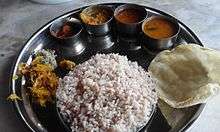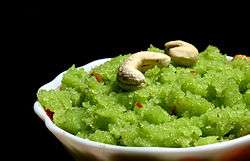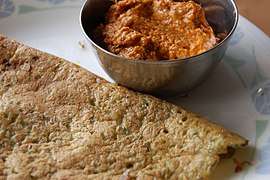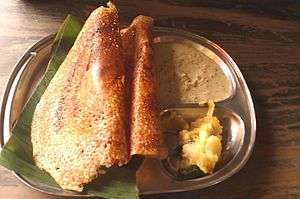South Indian cuisine
 |
| This article is part of the series |
| Indian cuisine |
|---|
|
Regional cuisines
|
|
Ingredients, types of food |
|
See also
|
|

South Indian cuisine includes the cuisines of the five southern states of India: Andhra Pradesh, Karnataka, Kerala, Tamil Nadu and Telangana.
Similarities and differences among cuisines

The similarities among the five states' cuisines include the presence of rice as a staple food, the use of lentils and spices, dried red chilies and fresh green chilies, coconut, and native fruits and vegetables including tamarind, plantain, snake gourd, garlic, and ginger. The four cuisines have much in common and differ primarily in the spiciness of the food.
Kerala, Tamil Nadu, south and coastal Karnataka and most parts of Andhra Pradesh use more rice. People also consume Ragi in large quantities in southern Karnataka. North Karnataka, on the other hand, consumes more bajra and sorghum, while the Telangana state uses more jowar and pearl millet. Consumption of rice is more common among certain Brahmin communities.
Andhra food

The cuisines of Andhra are the spiciest in all of India. Generous use of Chili and Tamarind make the dishes tangy and hot. The majority of a diverse variety of dishes are vegetable- or lentil-based.
Regional variations
The three regions of Andhra Pradesh have variations in the cuisine. Telangana region shares border with Central Indian and Vidharba, this area has more sorghum- and pearl millet-based rottas in their staple diet.
The Rayalaseema district shares borders with eastern Karnataka and Tamil Nadu, and its cuisine has similarities to that of those regions.
The more fertile Andhra coastal region has a long coastline along the Bay of Bengal, and its cuisine has a distinctive flavor with various seafood. Hyderabad, the capital of Telangana, has its own characteristic cuisine, which is considerably different from other Andhra cuisines. The Nizams patronise the Hyderabadi cuisine, which is very much like the Nawabi and Lucknowi cuisine. The only difference is that the Nizams of Hyderabad prefer their food to be spicier, resulting in the distinct Hyderabadi cuisine, which includes delicacies like Kacche gosht (Raw Meat) ki biryani, Dum ka Murgh (Chicken cooked in Hyderabadi Style), baghara baingan (Eggplant), and Achaari Subzi (Vegetable gravy with the taste of pickles).
Popular Andhra dishes
Vegetarian
Tiffins (Breakfast): pesarattu (mung bean pancake), attu, bobbatlu, pulihora or pulihaara (tamarind & lemon rice), upma
Pickles (pachhallu): ఊరగాయి(ఆవకాయి)(cut raw mango) pickle, maaghaya, gongura pachadi, pandumirapakayala pachadi, tomato pachadi, allam (ginger) pachadi, dosakaya pachadi, dosavakaya, chintakaya (tamarind)
Curries (kooralu): gutti vankaya, bendakaya fry, dondakaya fry, cabbage pesara pappu, carrot fry
Pappu (lentils)(పప్పు) varieties: thotakura (amaranth – pigeon pea stew) pappu, chukkakoora pappu, menthikura pappu, palakura pappu (spinach – pigeon pea dal), dosakaya (yellow cucumber – pigeon pea stew), tomato, beerakaya, sorakaya
Pulusu: palakoora pulusu, sorakaya pulusu, thotakoora pulusu, anapakaya pulusu, gongura pulusu koora
Chaaru: tomato chaaru, miriyala chaaru (pepper), ulava chaaru
Chaaru and curd variations: perugupachadi/majjiga chaaru with potlakaya (snake gourd), sorakaya (bottle gourd)
Snacks: sakinalu, chekkalu, murukulu, jantikalu, chakkilalu
Sweets: pootarekulu, kaaja, ravva laddu, boondi laddu, pesara laddu, sunnundalu, thokkudu laddu, ariselu, nuvvula laddu
Chutney and pickles
Raw pachadi-vankaya pachadi, dosakaya vanakaya pachadi, tomato pachadi, cabbage pachadi, pickles of avakaya (mango), usirikaya (Indian gooseberry), ginger, citroen, gongura, tomato, garlic
Non-vegetarian
Hyderabadi biriyani and various Hyderabadi meat dishes make up part of Hyderabadi cuisine. The rest of Andhra cuisine has various versions of lamb and chicken, and the coastal region has extensive varieties of seafood. Dishes include kodi iguru (chicken stew), kodi pulusu (chicken gravy), chepa pulusu (fish stew), fish fry and prawn curry.
Karnataka food

Karnataka cuisine is very diverse.The famous traditional south Indian breakfasts like idli, vada and masala dosa was invented in Karnataka in the temple streets of Udupi, which has now become the traditional South Indian food. Described as the mildest in terms of spice content of the five southern states' cuisines, there is a generous use of jaggery, palm sugar and little use of chili powder however Northern Karnataka cuisine, which can be extremely hot, is an exception. Since the percentage of vegetarians in Karnataka is higher than other southern states, vegetarian food enjoys widespread popularity.
Regional Karnataka cuisine
North Karnataka cuisine
In North Karnataka, the staple grains are sorghum and pearl millet, along with rice. Rotis made out of these two grains, along with side dishes made of eggplant, fresh spiced salads of vegetables sometimes with raw lentils, spiced and stewed lentils are popular and routinely eaten. North Karnataka people also consume a variety of spicy condiments including chutney powders (Shenga pudi, Gurol pudi, agasi pudi, yellu chatni pudi), raw chutneys and pickles. Of all the other regional cuisines in Karnataka, this is known for its fiery spice level and heat. Eateries called Khanavali, often run by families, serve inexpensive but tasty home-style food. Most of them are run by Veerashaiva and are vegetarian, but Khanavalis serving non-vegetarian food are not uncommon. North Karnataka is one such geographical area in India with a lower per capita consumption of meat.
Coastal Karnataka cuisine
The cuisine of coastal Karnataka is marked by widespread use of seafood, coconut and coconut oil. Rice is the staple grain and is the centerpiece of every meal. Gravies called "gassi" made from chicken, fish, meats are served with rice. Lentils and vegetables cooked with coconut, spices and tempered with mustard, curry leaves, and generous asafoetida, in a dish called huli, is also served with rice. A rasam-like preparation called saaru is also served with rice. The meal will also contain vegetable side dishes called palya. Other accompaniments include curd-based tambli, sweet-tangy gojju, pickles and happala, sandige(fryums) or papads. Some of the distinct breakfast foods served here include bun, biscuit roti, goli bajji, and patrode.
Popular pickles dishes include appemidi (found in Dandeli forest), bettada nelli, lemon, amateykai, and mixed vegetables.Chutneys include ground nut chutney, coconut chutney, and onion chutney.
Coorgi cuisine
Coorgi cuisine is very distinct from the other regional cuisines of Karnataka, much like their culture. The hallmark of Coorgi cuisine is the widespread use of pork, game, and meats. Kokum is generously used in their cooking. The staple food remains rice and rice-based preparations like kadambattu, steamed rice dumplings and rice rotis.
South Karnataka cuisine

The south Karnataka or the old Mysore cuisine is dominated by ragi, or finger millet, and rice. Ragi in the form of ragi mudde of dumplings or steamed rice is the centerpiece of a meal. Often served with these two dishes are vegetable sides or palya, and a selection of soups known as saaru. Items commonly made are gojju (a type of thick sweet and sour gravy with vegetables), uppinakai (pickled vegetables), tovve (a very mild soup of lentils, sometimes with vegetables), huli (a spiced sour soup of lentils, tamarind, and vegetables), and tili saaru (a type of thin, peppery soup). Certain preparations like bassaaru (a spiced soup of lentil stock with vegetables or greens), uppusaaru (a mild lentil stock based soup often accompanied with a raw chutney), masoppu (mashed spiced greens), and masekai (mashed spiced vegetables), are typical homestyle food from south Karnataka.


Avare kal (Indian beans) is a popular vegetable consumed during winter. They are used in a variety of dishes including usali, upma, huli, and hitakida bele saaru. Rice preparations usually served as the second course of a traditional meals include bisi bele baath, chitranna and puliyogre (tamarind rice)
Yogurt is a typical part of every meal in all the regions of Karnataka and is probably the most popular dairy product. Generally, yogurt with rice constitute the final course of a meal. Buttermilk laced with spices and curry leaves is also served with meals, especially during the summer. Ghee and butter are popular cooking mediums for those who can afford them, and are mostly reserved for festivals and special occasions.
Udupi hotels
The credit for popularising these foods elsewhere in India goes to Udupi hotels. In north India, Udupi hotels are often synonymous with south Indian food, even though the range of foods they serve is mostly restricted to the Karnataka cuisine. These small establishments serve inexpensive vegetarian breakfast dishes throughout the day all over India. The hotels are mostly run by people native to the Canara region. The famous masala dosa traces its origin to Udupi cuisine and was subsequently popularised by Udupi restaurants.
Karnataka dishes

People from Karnataka are notorious for their sweet tooth. Belagavi Kunda, Mysore pak, obbattu/holige, dharwad pedha, pheni, and chiroti are popular sweets. Other lesser-known sweets include "hungu," kajjaya, coconut mithai, karjikai, rave unde, sajapa, pakada pappu, chigali, a variety of kadubus, tambittu, paramanna, and hayagreeva. Most of these sweets are not milk-based, unlike the popular sweetmaking tradition elsewhere in India, but rather are made using jaggery instead of refined sugar.
Some typical breakfast dishes include masala Dosa, ragi rotti, akki rotti, Vangibath, menthya baath, tamato baath, khara baath, kesari baath, shavige baath, davanagere benne dosa, uppittu, plain and rave idli, mysore masala dosa, kadubu, poori, and avalakki.
Lunch items include (sambar) huli, (rasam) thili, kootu, gojju, a delicacy called bisi bele baath, chitranna, kosambri (salad), pachadi, and mosaru bajji.
Snack items include kodabale, chakkali, nippatu, maddur vade, aamb vade, golli bajji, and mangalore bun. Kids enjoy and relish the tasty and tangy Tamarind Chigali.
Kerala food


Kerala cuisine is very diverse, a diversity is best classified on the basis of the various communities. The Syrian Christian dishes and Malabari Muslim dishes are famous. Since Kerala's main export is coconuts, almost all of the dishes, irrespective of the variety in the cuisines of the different communities, have coconuts associated with them, either in the form of shavings or oil extracted from the nut. Seafood is also very popular in the coastal regions and eaten almost every day.
Popular Kerala dishes:
Vegetarian: olan, paalpradaman, nendarangai chips, aviyal, pulissery, erucherri, sambar, rasam, kalan, upperis, pachady, vegetable stew and kichadi
Non-vegetarian: shrimp coconut curry, fish curry (various versions depending on the region), fish fry, chicken fry with shredded coconuts, fish pickle, podimeen fry, meen thoran (fish with coconut), karimeen (pearl spot fish) pollichathu, shrimp masala, chicken stew, mutton stew, duck curry, malabari fish curry, fish molly, kakka (shells) thoran, kalllumekka, crabs, Pork Mappas (Panni Mappas), Pork vindallu (Panni Vindallu), Pork Roast, Beef ularthiyadhu (Pothu Ularthiyadhu), malabar biriyani, thalassery biriyani, pearl spot fish, jewel fish, mussels, squid, kappa boiled, kappa (tapioca) vevichathu with non- vegetarian curries
Malabar biriyani is a rice cuisine using khyma rice instead of basmati rice. This biriyani is known as Thalassery biriyani and is the only variety of biriyani in Kerala. [1]
Snacks: upperi, payasam, banana fry (ethaykkappam or pazham pori), ullivada, kozhukkatta, avalosunda, unniyappam, neeyyappam, unnaykka, thira, churuttu, boli, modhakam, paal vazhaykka, cutlets, halwas, cakes, vattayappam, kinnathappam, and irattymadhuram
Breakfast: puttu (with banana or kadala curry, egg curry, or beef fry), Appam (velayappam, palappam) with curry, vegetable stew, fish molee, chicken or mutton stew, beef curry, duck roast, pork masala, and idiyappam, pidi with mutton curry or chicken curry, porotta with chicken curry or mutton curry, idli, dosai with chutney, kanji with dry beans, pickle, pappadam made with black lentils.
Typical Indian masala dosa (Kerala style), is a combination of shredded, cooked, and fried vegetables with Indian sauce and several spices as the basic stuffing, enveloped by a thick brown dosa made out of a dal and rice batter. To embellish this unique preparation, it is served with hot sambhar and coconut chutney.
Tamil Nadu food


A typical Tamil meal consists of many spicy and non-spicy dishes. Many of these dishes are generally mixed and eaten with steamed rice, which is the staple food of the region. Except for Brahmins and a couple of non-Brahmin castes, most Tamilians eat non-vegetarian food. However, on a typical day, a Tamil family will eat mostly vegetarian food, and the intake of meat is lower than in most parts of the world.
Restaurants serving Tamil food are traditionally of two types - so called Saiva restaurants (serving only vegetarian food) and so called Asaiva restaurant (serving both non vegetarian and vegetarian food). Saiva restaurants serve people from all castes and religions. Fresh coffee and tea remain a staple drink served in both restaurants.[2]
Tamil cuisine groups dishes under five slightly overlapping categories.
Gravy dishes to be mixed in rice
First are the dishes that necessarily are mixed with rice. The sub-categories under this head are: kuzhambu, sambar, paruppu, rasam, and thayir. There is a great variety of dishes under each sub-category. For example, under "kuzhambu", common dishes include puli kuzhambu, vaththal kuzhambu, Molagu kozhambu, payarru kuzhambu, and mor kuzhambu.
Accompaniments
Foods in the second category are the side dishes that accompany such mixtures, including kootu , poriyal, oorukaai (pickles), vadaam, vaththal and Pappadam.
Standalone snacks
In the third category are the short snacks and their accompaniments, including vada, bonda, bajji, various chutneys, and thayir Pachadi.
Dessert
The fourth category encompasses the rich, sweet dishes that serve as desserts, including payasam, Kesari, thirukannamidu, sarkarai Pongal, Akkaravadisil, Theratti Paal and a plethora of other Indian sweets.
Fast foods, or light meals
The fifth category includes "tiffin," or light meals, which includes various types of idlis, dose, poori, pongal, uppma, idiyappam, aappam, adai, parotta, and paniyaram. Preparations from the fifth category are served for breakfast and early dinners, but usually not as a midday meal.
Tamil cuisine offers primarily light breakfast, lighter dinner, a heavy midday meal and evening snacks, often served with tea or coffee. The rasam is mixed with rice, usually eaten accompanied by crisps. The last of the courses will invariably be rice with curd or yogurt, usually taken along with pickles.
Throughout the meal, the side dishes are served and eaten with the courses, depending upon one's taste or choice. Side dishes are constantly replenished during any meal. Desserts are served as the last course. After the meal, guests retire to the living room and conclude with bananas and freshly made paan, consisting of betel leaves, betel nuts and lime. Paan is considered a digestive aid.
Tamil non-vegetarian meals are similar, except that the first and second courses are usually replaced by various biryanis and non-vegetarian gravies.
In either case, a typical meal (lunch or dinner) will be served on a banana leaf. Meals are often accompanied by various pickles and appalams.
Food is generally classified into six tastes–sweet, sour, salt, bitter, pungent and astringent. Traditional Tamil cuisine recommends that one includes all of these six tastes in each main meal eaten. Each taste has a balancing ability and including some of each provides complete nutrition, minimises cravings and balances the appetite and digestion.
- Sweet: milk, butter, sweet cream, wheat, ghee (clarified butter), rice, and honey
- Sour: limes and lemons, citrus fruits, yogurt, mango, and tamarind
- Salty: salt or pickles
- Bitter: bitter gourd, greens of many kinds, turmeric, and fenugreek
- Pungent: chili peppers, ginger, black pepper, clove, and mustard
- Astringent: beans, lentils, turmeric, vegetables like cauliflower and cabbage, and cilantro
Chettinad cuisine
Chettinad cuisine is famous for its use of a variety of spices in preparing mainly non-vegetarian food. The dishes are hot and pungent with fresh ground masalas, and topped with a boiled egg that is usually considered an essential part of a meal. They also use a variety of sun-dried meats and salted vegetables, reflecting the dry environment of the region. The meat is restricted to fish, prawn, lobster, crab, chicken and mutton. Chettiars do not eat beef and pork.
Most of the dishes are eaten with rice and rice-based accompaniments such as dosais, appams, idiyappams, adais and idlis. The Chettinad people, through their mercantile contacts with Burma, learnt to prepare a type of rice pudding made with sticky red rice.
Chettinad cuisine offers a variety of vegetarian and non-vegetarian dishes. Some of the popular vegetarian dishes include idiyappam, paniyaram, vellai paniyaram, karuppatti paniyaram, paal paniyaram, kuzhi paniyaram, kozhakattai, masala paniyaram, adikoozh, kandharappam, seeyam, masala seeyam, kavuni arisi and athirasam.
Popular Chettinad dishes:
Vegetarian:kevar kalli, idli, sambar, vadai, rasam, dosa, thayir sadam (yogurt rice), thayir vadai (yogurt-soaked fritters), kootu (vegetables in wet style), poriyal/kari (vegetables in dry style), murukku, uthappam, idiappam, appalam (deep fried lentil-flour crisps) and papadum (baked lentil-flour crips), freshly made thayir pachidi (yogurt mixed with fresh vegetables)
Non-vegetarian: karuvattu kuzhambu (salted, dried fish in sauce), chettinad pepper chicken, fish fry, and Kanji with "old fish" gravy
Image gallery
 Mysore pulavu
Mysore pulavu- Vegetarian meals in Tamil Nadu traditionally served on banana leaves
- Idli and sambar, a typical Tamil breakfast dish.
References
- ↑ My Singapore Kitchen : Thalassery Biriyani
- ↑ Shankar, Shylashri (16 December 2016). "A coffee break in tradition". Open the magazine. Retrieved 21 December 2016.




